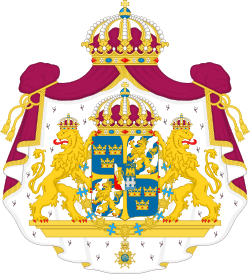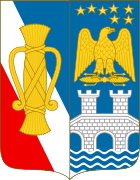House of Bernadotte
| House of Bernadotte | |
|---|---|
|
Arms of Bernadotte | |
| Country | Sweden, Norway |
| Titles |
"By the Grace of God King of the Swedes, the Goths and the Wends"
|
| Founded | 1810 |
| Founder | Jean Baptiste Jules Bernadotte |
| Final ruler | Norway: Oscar II |
| Current head | Carl XVI Gustaf of Sweden |
| Deposition | Norway: 1905 dissolution of the union between Norway and Sweden |
The House of Bernadotte, the current royal house of Sweden, has reigned since 1818. Between 1818 and 1905, it was also the royal house of Norway. Its founder, Charles XIV John of Sweden (who was born Jean Bernadotte), was adopted by Charles XIII of Sweden, whose House of Holstein-Gottorp was becoming extinct.
History of the Royal House
Following the Finnish War in 1809, Sweden lost possession of Finland, which had constituted the eastern half of the Swedish realm for centuries. Resentment towards King Gustav IV Adolf precipitated a coup d'état. Gustav Adolf (and his son Gustav) was deposed and his uncle Charles XIII was elected King in his place. However, Charles XIII was 61 years old and prematurely senile. He was also childless; one child had been stillborn and another died after less than a week. It was apparent almost as soon as Charles XIII ascended the throne that the Swedish branch of the House of Holstein-Gottorp would die with him. In 1810 the Riksdag of the Estates, the Swedish parliament, elected a Danish prince, Prince Christian August of Augustenborg, as heir to the throne. He took the name Charles August, but died later that same year.
At this time, Emperor Napoleon I of France controlled much of continental Europe, and some of his client kingdoms were headed by his brothers. The Riksdag decided to choose a king of whom Napoleon would approve. On 21 August 1810, the Riksdag elected Jean-Baptiste Bernadotte, a Marshal of France, as heir presumptive to the Swedish throne.

The coat of arms of the House of Bernadotte combines the coat of arms of the House of Vasa (heraldic right) and the coat of arms of Bernadotte as the Prince of Pontecorvo (heraldic left). It is visible as an inescutcheon in the Greater Coat of Arms of the Realm.
Some members of the house who lost their royal status and Swedish titles due to unapproved marriages have been given the titles Prince Bernadotte and Count of Wisborg in the nobility of other countries.
Bernadotte
Bernadotte, born in the town of Pau, in the province of Béarn, France, had risen to the rank of general during the French Revolution. In 1798, he married Désirée Clary, whose sister was married to Joseph, Napoleon's elder brother. In 1804, Napoleon promoted Bernadotte to a Marshal of France. Napoleon also granted him the title "Prince of Pontecorvo".
As the Crown Prince of Sweden, he assumed the name Charles John (Swedish: Karl Johan) and acted as regent for the remainder of Charles XIII's reign. In 1813, he broke with Napoleon and led Sweden into the anti-Napoleon alliance. When Norway was awarded to Sweden by the Treaty of Kiel, Norway resisted and declared independence, triggering a brief war between Sweden and Norway. The war ended when Bernadotte persuaded Norway to enter into a personal union with Sweden. Instead of being merely a Swedish province, Norway remained an independent kingdom, though sharing a common monarch and foreign policy. Bernadotte reigned as Charles XIV John of Sweden and Charles III John of Norway from 5 February 1818 until his death on 8 March 1844.
The House of Bernadotte reigned in both countries until the dissolution of the union between Norway and Sweden in 1905. Prince Carl of Denmark was then elected as King Haakon VII of Norway. Carl was a grandson of King Charles XV of Sweden and a great-great-grandson of Charles XIV.
French origins
King Charles John's first known paternal ancestor was Joandou du Poey, who was a shepherd. He married Germaine de Bernadotte in 1615 in the southern French city of Pau and began using her surname. Through her the couple owned a building there called de Bernadotte.[1]
A grandson of theirs, Jean Bernadotte (1649–1698), was a weaver.[2]
Another Jean Bernadotte (1683–1760), his son, was a tailor.[3]
His son Henri Bernadotte (1711–1780), father of the future Swedish–Norwegian king, was a local prosecutor, from a family of weavers and artisans,[4] who had once been imprisoned for debt.[5][6] This is a modest family which occupies only one floor of the house in a cross street in a popular and peripheral district of Pau.[7]
Two branches of the French Bernadotte family survive. The elder descends from Andrew (André) Bernadotte, an older granduncle of Carl John's, with descendants today in the general population of France. The younger branch divided in two, one branch descending from the king's older brother John (Jean Évangéliste) Bernadotte (1754–1813), the heads of which were French barons as of 1810 with Louvie Castle[8] in the south of Pau as their seat (branch extinct with the death of Baron Henry Bernadotte in 1966), and the other branch being the Swedish Royal House.[9]
Kings of Sweden

- 1818–1844: Charles XIV John (Karl XIV Johan)
- 1844–1859: Oscar I
- 1859–1872: Charles XV (Karl XV)
- 1872–1907: Oscar II
- 1907–1950: Gustaf V
- 1950–1973: Gustaf VI Adolf
- 1973–present: Charles XVI Gustaf
Kings of Norway
- 1818–1844: Charles III John
- 1844–1859: Oscar I
- 1859–1872: Charles IV
- 1872–1905: Oscar II
Entire royal house
The list excludes in-laws and has persons currently alive (2015) in italics, all listed primarily as Swedish royalty unless otherwise noted.
- King Charles XIV John (1763-1844) of Sweden, Charles III John of Norway
- King Oscar I (1799-1859) of Sweden and Norway
- King Charles XV (1826-1872) of Sweden, Charles IV of Norway
- Prince Charles Oscar of Sweden and Norway (1852-1854), Duke of Södermanland
- Queen Louise of Denmark (1851-1926), Princess of Sweden and Norway
- Prince Gustav of Sweden and Norway (1827-1852), Duke of Uppland
- King Oscar II (1829-1907) of Sweden and Norway
- King Gustaf V (1858-1950), né Prince of Sweden and Norway
- King Gustaf VI Adolf (1882-1973), né Prince of Sweden and Norway
- Prince Gustaf Adolf, Duke of Västerbotten (1906-1947)
- King Carl XVI Gustaf (born 1946)
- Crown Princess Victoria, Duchess of Västergötland (b. 1977)
- Princess Estelle, Duchess of Östergötland (b. 2012)
- Prince Oscar, Duke of Skåne (b. 2016)
- Prince Carl Philip, Duke of Värmland (b. 1979)
- Prince Alexander, Duke of Södermanland (b. 2016)
- Princess Madeleine, Duchess of Hälsingland and Gästrikland (b. 1982)
- Princess Leonore, Duchess of Gotland (b. 2014)
- Prince Nicolas, Duke of Ångermanland (b. 2015)
- Crown Princess Victoria, Duchess of Västergötland (b. 1977)
- Princess Margaretha, Mrs. Ambler (b. 1934)
- Princess Birgitta of Sweden and Hohenzollern (b. 1937)
- Princess Désirée, Baroness Silfverschiöld (b. 1938)
- Princess Christina, Mrs. Magnuson (b. 1943)
- King Carl XVI Gustaf (born 1946)
- Prince Sigvard, Duke of Uppland (1907-2002)
- Prince Bertil, Duke of Halland (1912-1997)
- Prince Carl Johan, Duke of Dalarna (1916-2012)
- Queen Ingrid of Denmark (1910-2000), Princess of Sweden
- Prince Gustaf Adolf, Duke of Västerbotten (1906-1947)
- Prince Wilhelm of Sweden and Norway (1884-1965), Duke of Södermanland
- Prince Lennart, Duke of Småland (1909-2004)
- Prince Erik of Sweden and Norway (1889-1918), Duke of Väatmanland
- King Gustaf VI Adolf (1882-1973), né Prince of Sweden and Norway
- Prince Oscar of Sweden and Norway (1859-1953), Duke of Gotland
- Prince Carl of Sweden and Norway (1861-1951), Duke of Västergötland
- Prince Carl, Duke of Östergötland (1911-2003)
- Princess Margaretha of Denmark, Norway and Sweden (1899-1977)
- Crown Princess Märtha of Norway (1901-1954), née Princess of Sweden and Norway
- Queen Astrid of the Belgians (1905-1935), Princess of Sweden
- Prince Eugen of Sweden and Norway (1865-1946), Duke of Närke
- King Gustaf V (1858-1950), né Prince of Sweden and Norway
- Prince August of Sweden and Norway (1831-1873), Duke of Dalarna
- Princess Eugenie of Sweden and Norway (1830-1889)
- King Charles XV (1826-1872) of Sweden, Charles IV of Norway
- King Oscar I (1799-1859) of Sweden and Norway
See also
- Guadeloupe Fund
- Bernadotte af Wisborg
- Swedish Act of Succession
- Line of succession to the Swedish throne
- Bernadotte Armorial
- Bernadotte, Illinois
Sources
- ↑ Ätten Bernadotte : biografiska anteckningar, [Andra tillökade uppl.], Johannes Almén, C. & E. Gernandts förlag, Stockholm 1893, p. 1
- ↑ (in French). geneanet.org http://gw.geneanet.org/eallain?lang=fr;pz=timothe;nz=billard;ocz=0;p=jean;n=bernadotte. Missing or empty
|title=(help) - ↑ (in French). geneanet.org http://gw.geneanet.org/eallain?lang=fr;pz=timothe;nz=billard;ocz=0;p=jean;n=bernadotte;oc=1. Missing or empty
|title=(help) - ↑ "Bernadotte : un général de Napoléon devenu du Roi de Suède" (in French). ndf.fr.
- ↑ Bulletin du Musée Bernadotte volume 3-4, Pau 1958–1959, p. 57
- ↑ "Le fabuleux destin de Jean-Baptiste Bernadotte : de Pau à Marseille" (in French). lefrancofil.com.
- ↑ "Victoria de Suède sur les pas de son aïeul" (in French). larepubliquedespyrenees.fr.
- ↑ "Photo du Château Louvie, à Jurançon - Côté Est" (in French). J. Callizo, photographe (1909).
- ↑ Bulletin du Musée Bernadotte charts on ancestry
- Jean-Marc Olivier, "Bernadotte Revisited, or The Complexity of a Long Reign (1810–1844)", in Nordic Historical Review, number 2, October 2006, pp. 127–137.
External links
- The Bernadotte dynasty family tree on Kindo
- The Bernadottes in Black and White, photos from an exhibition at the Nationalmuseum, Stockholm.
- Kings of the House of Bernadotte
| House of Bernadotte | ||
| Preceded by House of Oldenburg (Holstein-Gottorp branch) |
Ruling House of the Kingdom of Sweden 1818–present |
Incumbent |
| Ruling House of the Kingdom of Norway 1818–1905 |
Succeeded by House of Oldenburg (Glücksburg branch) | |
